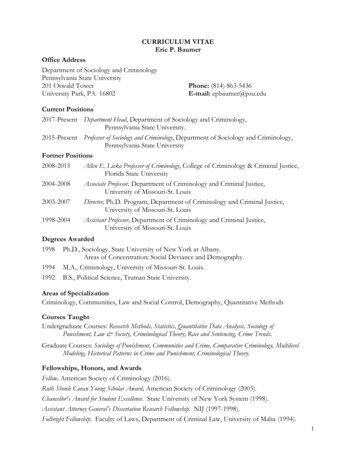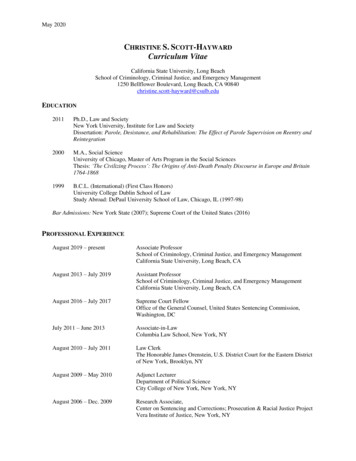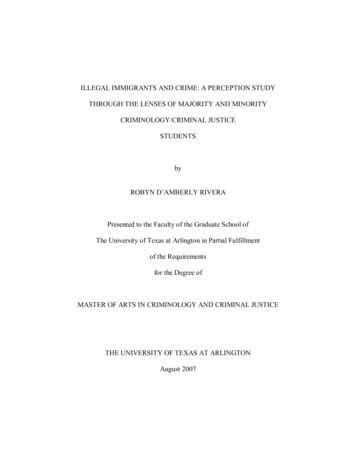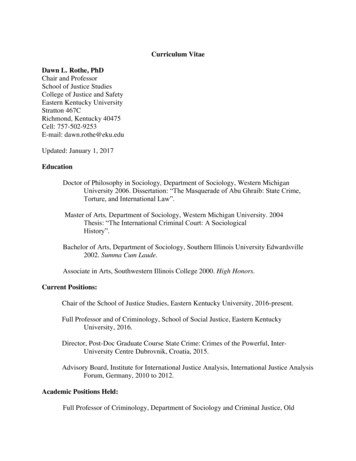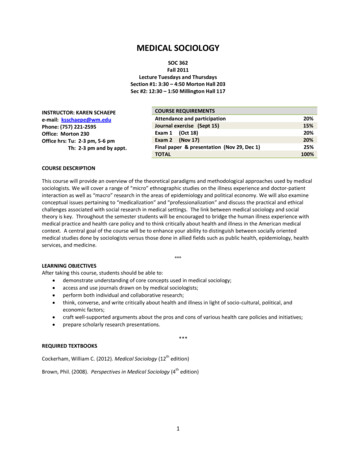
Transcription
Sociology, Criminology Concentrations, andCriminal Justice: Differences in Reasons forMajoring, Skills, Activities, and Early Outcomes?Mary S. Senter, Central Michigan UniversityNicole Van Vooren and Roberta Spalter-Roth, American Sociological AssociationApril, 2014INCREASED INTEREST IN CRIMINAL JUSTICEAnecdotal stories and survey data from sociologydepartment chairs and other faculty members suggestconcern about the role of the criminal justice majorboth as part of a joint department with sociology andas a separate department within a college or university.Worries center on the loss of the sociology major and adecrease in positions and other resources for sociologydepartments. These concerns appear to be increasingas departments fear losing potential majors to morevocationally-oriented programs, and the number ofcriminology and criminal justice majors increase compared to those who major in sociology without thisconcentration. Data from the most recent departmentsurvey of chairs shows that 85% of departments developed new courses in the previous three years, with thelargest number (21%) in the area of criminology andcriminal justice. Some sociology departments havedeveloped criminal justice majors, and some department chairs in last year’s survey note a decrease insociology majors as criminal justice majors increase(Spalter-Roth, Van Vooren, and Kisielewski, 2013).This brief, based on data from two waves of the 2012Bachelor’s and Beyond Survey, provides some evidence that these concerns may be given too muchweight, and that combined sociology and criminaljustice majors within sociology departments canpotentially improve the effectiveness of each.To respond to department chairs’ concerns about therelative growth of criminology and criminal justicemajors compared to sociology majors and the contestedrelations between them, the American SociologicalAssociation’s (ASA) elected council established The TaskForce on Sociology and Criminology Programs in 2006and charged it with “considering the various structuralarrangements between sociology and criminology inacademia, examining the potential benefits and challenges that these various arrangements pose. In addition, they should develop a set of recommendations to
Sociology and Criminologyenhance the effectiveness and efficiency of thesearrangements.” The task force in its 2010 report notedthe diverse ways in which sociology and criminaljustice programs were linked in universities and thestrengths and weaknesses of various structural arrangements (see report at http://www.asanet.org/documents/teaching/pdfs/ASA TF Report FINAL.pdf ). As part of its research the Task Force surveyeda sample of 47 sociology department chairs atpost-secondary institutions with programs in sociology and criminology. Although the chairs reportedthe number of students in these 47 programs,they did not include an analysis of the perceptionsand experiences of students in these programs.This research brief compares the ways in whichstudents’ perceptions and experiences differ amongthree types of majors. These are a general or “noconcentration” or “straight” sociology major, thosewith a joint sociology and criminal justice major,and those with a sociology major with an emphasisor concentration in criminal justice. The data arefrom the responses to the first and second wavesof a longitudinal survey of sociology majors, “Social Capital, Organizational Capital, and the JobMarket for New Sociology Graduates” funded bythe National Science Foundation. The first waveof the data was collected when respondents wereseniors in spring of 2012, and the second wave wascollected the winter of 2012/2013 after studentshad completed their undergraduate degrees.DESIGNThe First WaveIn the fall of 2011, the ASA Research Departmentdeveloped a questionnaire for the first wave ofthe survey, with the help of the project’s advisorycommittee. 1 A total of 233 departments agreed toparticipate in the first wave of the study by sendingus a list of sociology majors. Ultimately, 160 departments sent their lists after obtaining institutionalreview board (IRB) and/or any institutional approval2necessary to disclose this information beyond theIRB approval granted to ASA by the Western Institutional Review Board. Questions focused on students’experiences as sociology majors, including why theymajored; skills and concepts they learned; activitiesin which they participated; their job and graduateschool aspirations; and the contacts used in findingappropriate jobs and graduate schools. The final version of the survey was launched with an invitationalemail to students in March 2012, which was followedup with four reminder emails before the surveyclosed in early May. By the time it closed, 2,695students responded to for an average departmental response rate of 36.8%. These data (and thosethroughout this report) were weighted by genderto approximate better the male/female distributionamong the national population of sociology majors.The Second WaveIn the fall of 2012, the Research Department withthe aid of the project’s advisory committee developed the questionnaire for the second wave ofthe B&B survey conducted about seven monthsafter graduation. The second wave surveyreplicated many questions from the previous studyof the post-graduation experiences of the 2005cohort of senior sociology majors. The survey wasapproved by the Western Institutional Review Board(WIRB), and was developed as an online survey bythe Indiana University Center for Survey Research.A letter of invitation was sent to all of the 2,695respondents who participated in the first wave ofthe study asking them to respond to the secondwave that asked questions about their employmentand/or graduate school status, the characteristicsof jobs, and their job satisfaction. These questionswere skipped by those respondents who attendedgraduate school but were not employed. The surveywas closed in February of 2013. The total responserate was just over 41% (1,108 completed surveys).An additional 62 respondents returned partiallycompleted surveys, with 127 “not deliverable” and15 refusals for a refined response rate of just overThe Advisory Committee consists of the project co-PI Mary Senter of Central Michigan University, Margaret (Peggy) Nelson of MiddleburyCollege, John Kennedy of Indiana University, Pamela Stone and Michael Wood of Hunter College, City College of New York.1
3Sociology and CriminologyFIGURE 1: TYPE OF INSTITUTION ATTENDED AMONG SOCIOLOGY MAJORS BY PROGRAM TYPE(PERCENT ATTENDING EACH TYPE OF SCHOOL)Sociology Alone57.2Sociology Major w/Criminology EmphasisSociology and Criminology BaccalaaureateSOURCE: American Sociological Association. Social Capital, Organizational Capital, and the Job Market for New SociologyGraduates, 2012, Waves I and II.44%—a higher response rate than for the first survey.For more detailed descriptions of the research design,see Beyond Sociology Majors Brief 2013.pdf forthe first wave of the study and http://www.asanet.org/documents/research/pdfs/Bach Beyond5 Social Capital.pdf for the second wave of the survey.jors; and those who describe themselves as sociologymajors with an emphasis or orientation in criminology. In deriving these categories, we are dependenton respondents’ understanding of the questions andtheir perceptions of the nature of their major. In addition, if we had the full universe of majors, the relative size of each of the categories might be different.For this brief, we use responses from those who answered both the first and second wave survey to createthree categories of majors, those who majored in sociology without reporting a joint major or an emphasisor orientation in a sub-field; those who describedthemselves as joint sociology and criminal justice ma-FINDINGSA straight sociology major (without a joint degreeor a concentration in criminal justice) appears to bedominant in sociology departments. About half of therespondents (49%) describe their major in the first wave
Sociology and Criminology4TABLE 1: IMPORTANT REASONS FOR CHOOSING THE MAJOR: SIGNIFICANT DIFFERENCES INPERCENTAGES FOR THREE TYPES OF SOCIOLOGY PROGRAMSSociologySociology w/CriminologyEmphasisSociology andCriminal JusticeConcepts interested me**97.898.994.2Enjoyed the first course**90.188.581.0Prepare me to understand different socio-economicsituations*89.797.788.7Prepare me for the job I want**60.767.480.6Heard good things about the department*49.363.252.8* sig. .05** sig .01SOURCE: American Sociological Association. Social Capital, Organizational Capital, and the Job Market for New SociologyGraduates, 2012, Waves I and II.as “sociology alone.” The largest group of respondents(12%) with joint majors list “sociology and criminaljustice.” Among those sociology majors who report anemphasis or orientation, criminology is the second mostlikely to be listed (7%), with social work as the mostcommon emphasis (13%). Students with the combinedmajor are more likely to enroll at Master’s institutions(51%), while straight sociology majors are more likelyto come from Baccalaureate (11%) or Doctoral (57%)schools. Those respondents with a criminology emphasis are similar to those with a sociology “alone” majors,with 59% at Doctoral schools and 9% at Baccalaureateonly institutions. The percentage of respondents listingthese three types of majors can be seen in Figure 1.in sociology. Although there is a statistically significantdifference among the three types of majors, more than90% of all respondents major because they are interested in sociological concepts. Sociology majors witha criminology emphasis are more likely than straightsociology majors to see their program as helping toprepare them for jobs, to understand how individualsfunction in different socio-economic situations, and tohave chosen the major because they had heard goodthings about their specific department. There are nostatistically significant differences in other reasonsfor majoring including helping respondents learn tochange society, to understand their lives, or to preparethem to do different types of research (data not shown).Differences and Similarities inMotivation for the MajorDifferences and Similarities inParticipation in ActivitiesThe first wave survey of senior sociology majors showsseveral significant differences among the three groupsin their reasons for choosing the type of major (Table1). Joint sociology and criminal justice majors are morelikely than straight sociology majors to report that themajor would prepare them for the job they wanted—adifference of 20 percentage points—and are also slightly less likely to major because they enjoy the first courseTable 2 presents the types of activities in which majors participated. With one exception, that of “studyabroad,” there are no statistically significant differencesamong the types of majors. One other non-classroomactivity is close to significant (.058): slightly more thanone half of sociology and criminal justice majors report participating in a student internship, while lessthan one of half of sociology majors, including those
Sociology and Criminology5TABLE 2: ACTIVITY PARTICIPATION: SIGNIFICANT DIFFERENCES IN PERCENTAGES FOR THREETYPES OF SOCIOLOGY PROGRAMSSociologySociology w/CriminologyEmphasisSociology andCriminal JusticeGroup or team projects92.889.889.8Study groups for a class81.881.676.6Received mentoring advice67.270.164.9Community or volunteer activity61.254.059.5Saw a career advisor57.052.353.4Job fairs/networking50.051.754.7Work with a group advocating for some cause48.644.845.7Service learning project46.444.842.6Internship (p .058)45.140.051.9Worked on independent study32.332.226.3Leadership development27.130.730.8Alpha Kappa Delta/Sociology Club23.717.021.6Study abroad**20.78.011.0Honors Program16.910.217.4Attended state or regional sociology meeting15.616.113.4* sig. .05** sig .01SOURCE: American Sociological Association. Social Capital, Organizational Capital, and the Job Market for New SociologyGraduates, 2012, Waves I and II.with a criminology emphasis, have had this experience. For the rest of the activities, the commonality ofexperience is more marked than differences. At leastthree quarters of each type of major attend studygroups or work on group projects. About two-thirdssaw mentors. More than half of each type of majorparticipates in community and volunteer activitiesand attends a job fair or other networking activities.Differences and Similarities in Learning2Methodological Skills and ConceptsWhat is noteworthy in this analysis are the similarities instudents’ reports of what they learn in the three typesof majors. There are no differences between sociologymajors and sociology and criminal justice majors acrossfive of six areas of conceptual learning2 and 13 of 15skill areas (see Appendix Table 1 for skill areas). AsAppendix Table 1 shows there are no significant differences in the reported mastery of skills among the threeIn order to have high enough cell N’s, the categories “not much” and “not at all” were combined for the tests of statistical significance.
Sociology and Criminology6TABLE 3: LEARNING OF SOCIOLOGICAL CONCEPTS: SIGNIFICANT DIFFERENCES INPERCENTAGES FOR THREE TYPES OF SOCIOLOGY PROGRAMSSociologySociology w/CriminologyEmphasisSociologyand CriminalJusticeCONCEPT ”Yes, definitely:” Explain differences in life experiences 386.781.883.5CONCEPT “”Yes, definitely:” Explain basic concepts 486.381.681.578.680.775.7CONCEPT “”Yes, definitely:” Discuss sociological theories77.677.376.6CONCEPT “”Yes, definitely:” Discuss social 50.05.0CONCEPTSKILL“”Yes, definitely:” Present sociological explanations aboutsocial issues (p .055)“A great deal:” Create a hypothesis with independent anddependent variables*SKILL “Very little:” résumé writing* 5CONCEPT“Not much” or “not at all:” Can identify the impact andconsequences of social policy* 6* sig. .05** sig .01SOURCE: American Sociological Association. Social Capital, Organizational Capital, and the Job Market for New SociologyGraduates, 2012, Waves I and II.types of majors. All three groups of respondents aremost likely to report that they have “a great deal” of familiarity with gathering information to make evidencebased arguments, identifying ethical issues, and working with diverse groups. Respondents are least likelyto report that they are familiar with writing research orgrant proposals and using different types of software.In terms of sociological concepts, more than three-quarters of each group of respondents agree that theycan definitely explain basic sociological concepts;explain differences in life experiences as they vary byrace, gender, and class; present sociological explanations about social issues; and discuss sociologicaltheories and social institutions (Table 3). However, theTable shows that there are three significant differencesamong the groups. Sociology majors with a criminol-Expected frequencies for more than 20% of cells are less than five.Expected frequencies for more than 20% of cells are less than five.5The percentages for “a great deal” are 33.6% for sociology alone, 37.3% for criminology emphasis, and 37.4% for sociology and criminal justice.6The percentages for “yes, definitely” are 62.8% for sociology alone, 59.8% for criminology emphasis, and 64.9% for sociology and criminaljustice.34
Sociology and Criminology7TABLE 4: SIGNIFICANT DIFFERENCES IN PERCENTAGES FOR THREE TYPES OF SOCIOLOGYPROGRAMSSociologySociology w/CriminologyEmphasisSociology andCriminal JusticeOverall satisfaction776.067.872.9Ease of contacting faculty outside of class*70.967.870.1Opportunity to interact with peers*67.867.871.4Quality of teaching67.072.764.4Ease of getting courses needed62.763.665.3Out of class activities**42.242.947.6Quality of undergraduate advising54.258.058.3Graduate school advising*27.429.437.8Quality of career advising26.929.332.8* sig. .05** sig .01SOURCE: American Sociological Association. Social Capital, Organizational Capital, and the Job Market for New SociologyGraduates, 2012, Waves I and II.ogy emphasis report at least some attention to identifying the impact and consequences of social policycompared to straight sociology majors who are lesslikely to do so. Another difference of note is that morethan one third of sociology majors report very littleattention to résumé writing in their program, while theother two groups report greater likelihood of learning this skill that is important for job search. Further,straight sociology majors are least likely to report highskill levels when it comes to hypothesis creation.Differences and Similarities in SatisfactionAs noted, there is one major difference as to whystraight sociology and joint criminal justice and sociology majors choose their field of study; joint majors are20 percentage points more likely to expect to be prepared for a career than are their peers with a straight sociology major, even though their experiences and levelsof learning are similar. Do these differences in motivation, coupled with the commonality of experience, leadto differing levels of satisfaction among the three typesof majors, while they are still undergraduates? Table 4shows that there are no large differences in overall satisfaction rates with these three types of majors. However,sociology majors with an emphasis on criminology arethe least satisfied (68%) while straight sociology majorsSociology majors are especially dissatisfied with their out of class activities with 13.3% expressing the lowest level of satisfaction (compared toonly 4.4% of social and criminal justice majors). The higher level of satisfaction for graduate school advising for sociology and criminal justicemajors may reflect, in part, the lower N for this question. Students not interested in attending graduate school had the option not to answer thequestion.8Significance level based on two categories (very satisfied and other) to ensure high enough expected frequencies for the chi-square statistic.7
Sociology and Criminology8FIGURE 2: POST GRADUATE JOBS AND SCHOOL AMONG SOCIOLOGY MAJORS BY PROGRAMTYPE (PERCENT PARTICIPATING IN EACH ACTIVITY)Sociology alone58.356.0Sociology major, Criminology EmphasisSociology and Criminology Major57.819.27.12.0Working at a job,only0.02.016.020.017.612.78.17.84.0Working at anEnrolled in classes, Both working andunpaid internship,onlyenrolledonlyNeither working orenrolled in classes5.3 4.02.0OtherSOURCE: American Sociological Association. Social Capital, Organizational Capital, and the Job Market for New SociologyGraduates, 2012, Waves I and II.are the most satisfied (76%). There are no statisticallysignificant differences in the satisfaction with career advising, with only about 30% reporting high satisfaction,or the satisfaction with quality of teaching, with abouttwo-thirds or more reporting being “very satisfied” withthis aspect of the major. Four aspects of the major doshow statistically significant differences, although thedifferences are not very large. Sociology and criminaljustice majors are slightly more likely than sociologyalone majors to indicate that they are “very satisfied”with their out-of-class activities, their opportunityfor interaction with peers, and their graduate schooladvising (while statistically significant, the satisfactionof all groups with graduate school advising is relativelylow ).8 All three groups are highly satisfied with theease of seeing faculty outside of class, although thedifference among groups is statistically significant.Differences in Subsequent EmploymentData from the second wave of the Bachelor’s andBeyond project allow us to explore whether the postbaccalaureate employment of these three groups ofmajors differs, and whether the desire to be preparedfor a job in one’s field is fulfilled. We find a mixedpicture. This discussion focuses most on the sociology “alone” and the sociology with criminal justicemajors, because the response rate of sociology majorswith a criminology emphasis for the second wave islow. The three groups of majors are equally likely tobe employed or to be in graduate school: with 58%of straight sociology majors, 56% of sociology majors
Sociology and Criminology9TABLE 5: EMPLOYMENT STATUS: SIGNIFICANT DIFFERENCES IN PERCENTAGES OR MEANSFOR SOCIOLOGY AND JOINT SOCIOLOGY AND CRIMINAL JUSTICE MAJORSSociologySociology andCriminal JusticeEmployed in a “career-type” job59.050.0Current job leads to career56.960.6Job requires bachelor’s degree or higher*Employed in educational institution (p .072)Employed by government*Mean number of research tasks (of eight) used on the job*45.824.021.330.512.135.9Mean 1.50Mean 0.98Social services, counselors22.014.3Clerical/administrative support13.817.5Employment Category**Sales/marketingTeachersService occupations (including waitresses, police, cooks)Other professional (including IT, PR, and program assistant)Social science researcherManagement-relatedOther* sig. ** sig .01SOURCE: American Sociological Association. Social Capital, Organizational Capital, and the Job Market for New SociologyGraduates, 2012, Waves I and II.with criminology emphasis, and 58% of sociology andcriminal justice majors working at a paid job only (seeFigure 2). Thus, the majority of all three types of majorsare in the workforce. A small percent of majors areattending graduate school but are not employed: 7%of sociology alone majors, 4% of sociology majors withcriminology emphasis and 8% of social and criminaljustice majors are enrolled for classes at a college oruniversity only. Finally, 19% of sociology alone majors,16% of sociology majors with criminology emphasis, and 18% of sociology and criminal justice majorscombine paid employment with continuing education.There are, however, some career differences in employ-ment position among the two types of majors. Thereare statistically significant differences in the distribution of alumni in different types of jobs: social servicesand counseling are the largest job category for straightsociology majors, while service occupations are thelargest category for joint majors. Straight sociologymajors are twice as likely to work at educational institutions, while joint sociology and criminology majorsare significantly more likely to work for the government, including the military. Straight sociology majorsare more likely than joint majors to report that theyhold jobs that do require a bachelor’s degree. Sociology majors are more likely than joint sociology and
Sociology and Criminology10TABLE 6: SOCIOLOGICAL SKILLS AND CONCEPTS USED ON THE JOB: PERCENTAGES ANDMEANS FOR SOCIOLOGY AND JOINT SOCIOLOGY AND CRIMINAL JUSTICE MAJORS 9SociologySociology andCriminal JusticeNo sociology-related skills used18.321.54-7 sociology-related skills used24.427.71-3 sociology-related skills usedMean number of sociology-related skills used, for those who listemployment categoryDegree in sociology has helped in duties on the job57.350.8Mean 2.37Mean 2.2574.769.5SOURCE: American Sociological Association. Social Capital, Organizational Capital, and the Job Market for New SociologyGraduates, 2012, Waves I and II.criminology majors to view their job as a “career-typejob”—59% versus 50%, respectively (although thisdifference is not statistically significant). Sociology majors are more likely to report that they do a variety of“research tasks” (such as survey research construction,research project management, interviewing, focusgroups, quantitative data analysis, qualitative dataanalysis, and web searches) as a routine part of theirpositions. While means are low (as might be expectedwith recent graduates with bachelor’s degrees), there isa significant difference in the mean number of researchtasks that they do. Seventeen percent of sociologymajors and only 8% of sociology and criminal justicemajors report using routinely four or more of the eightresearch tasks analyzed here. There is no significantdifference in the percentage of these alumni groupsreporting that their current job is likely “to lead youto where you’d like to be career-wise in the next fiveyears,” with 57% of sociology alone majors and 61% ofsociology and criminal justice majors reporting thatthis is “very likely” or “somewhat likely” to be the case.While sociology majors appear significantly morelikely to have jobs that require more than a highschool degree and that routinely involve researchtasks, joint criminology and sociology majors are noless satisfied than sociology majors with their current jobs and are as likely to report that their workis related to their sociology degree. Slightly morethan one third of each group is “very satisfied” withtheir job, with an additional 43% of sociology majors and 39% of combined majors being “somewhatsatisfied”. Twenty-one percent of each group ofmajors report that their job is “closely related” totheir sociology degree with another 48% reportingthat their work on the job is “somewhat related.”Similarly, employed sociology and criminal justicemajors are as likely as sociology majors to reportthat they use a variety of sociology-related skills andconcepts on the job. These include skills such as “datacollection” and “report writing” as well as conceptssuch as “current sociological explanations about avariety of social issues” and “basic concepts in sociology.” Only 18% of sociology majors report using noneof these sociological skills and concepts on the jobalong with 21% of joint sociology and criminal justicemajors. About one quarter of each major report usingbetween four and seven of the skills/concepts measured here (Table 6). Perhaps most important for theirSociological skills include data collection, interpretation of data, report writing, identifying ethical issues in research, identifying basic sociological concepts, developing sociological explanations of social problems, understanding diverse life experiences.9
Sociology and Criminologyfuture, fully three quarters of sociology majors andalmost as many joint majors affirm that their degree insociology has helped them in their duties on the job.DISCUSSIONThere are relatively few statistically significant differences between sociology majors and joint sociologyand criminal justice majors as seniors and as recentlygraduated alumni. One statistically significant difference is their reason for majoring. Joint sociology andcriminal justice majors are more likely to report thatthey major because they want to be prepared for ajob, and their programs appear more likely to includesome job preparation activities such as internships.Yet, these joint more vocationally-oriented majors areless likely than straight sociology majors to obtain jobsthat require a bachelor’s degree and more likely to beemployed in service jobs. In addition, joint sociologyand criminal justice majors are less likely to obtain jobsthat routinely involve research tasks. Although straightsociology majors appear to obtain jobs that are morecareer-oriented, each group is similarly satisfied withthe overall aspects of their programs and the positionsthey obtain after graduation. Regardless of the kind ofjob, both groups report low levels of satisfaction withthe career and graduate school advising that couldhelp them find career-level positions after graduation.These findings suggest that there is substantial overlap between the types of majors. It is likely, therefore,that from the perspective of majors, departmentscan create academic programs that join sociologyand criminal justice without creating a “second rate”experience for students—either in terms of learningconcepts and skills, levels of student satisfaction withtheir academic programs, or their subsequent employment. However, departments that have developedor are considering developing a joint sociology andcriminology major need to encourage the continuedteaching of basic sociological theories, concepts, andmethods across all courses in all three types of majorsas well as show how these skills and concepts can beused in practice. Straight sociology programs shouldrecognize the need for post-graduation employmentand do an even better job of helping students to gaincareer jobs that require higher education by devel-11oping internship programs and teaching how writea résumé (see Spalter-Roth, Senter, and Van Vooren(2010) on launching majors into the workforce A Launching Majors Faculty Manual 2010.pdf ).Joint sociology and criminal justice majors who havea commitment to working for the government orwho have a passion for understanding the social andcriminal justice system should be encouraged in thosedirections. However, these data suggest that weshould not encourage the view among undergraduates that joint sociology and criminal justice majorswill be more likely than their straight sociology peersto find employment that is satisfying. Similarly, thesedata should provide some assurance to students andtheir faculty advisors that the sociology alone majoris appropriate for those wanting or needing to enterthe work force directly after receiving their undergraduate degrees and is not only for those studentswho plan on directly attending graduate school.Regardless of the type of major, sociology departments should consider ways of enlarging the rangeof jobs that students consider after graduation andhelping students develop sociologically meaningful skills that enhance careers and job searches aswell as developing activities, networks, and otherforms of social capital (see Spalter-Roth, Van Vooren,Kisielewski, and Senter (2013) at http://www.asanet.org/documents/research/pdfs/Bach Beyond5 Social Capital.pdf ) . This may be especially importantfor joint sociology
criminology and criminal justice majors increase com-pared to those who major in sociology without this concentration. Data from the most recent department survey of chairs shows that 85% of departments devel-oped new courses in the previous three years, with the largest number (21%) in the area of criminology and criminal justice.

